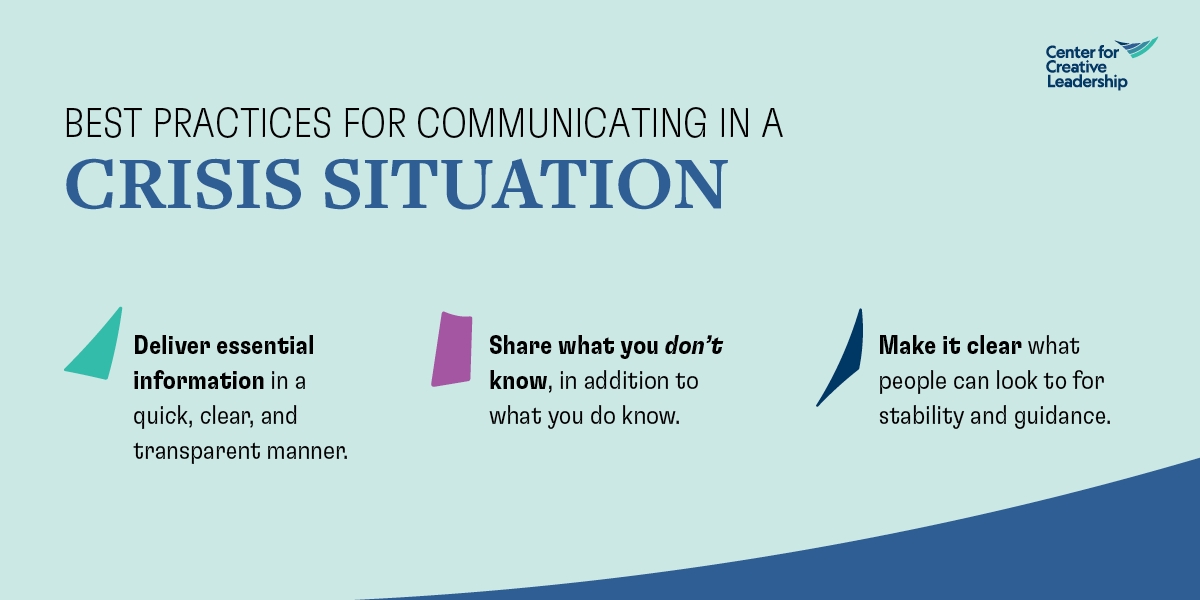Crisis Management Communication Tips for Leaders
During a crisis like the current pandemic and its economic aftermath, you’re undoubtedly dealing with some level of “information overload.” From the barrage of news updates to the endless torrent of communications from brands about how they’re dealing, to the best efforts of governments and health officials to provide accurate guidance, it’s natural to feel a bit overwhelmed.
Out of all the information, data, and speculation being thrown around, how do you decide what, when, and how to communicate with your team and organization?
Leaders around the world must know how to lead through a crisis and are seeking best practices for communicating in a crisis.
At CCL, we consider communication one of the essential functions of a leader. In fact, it’s one of the “Fundamental 4” leadership skills we’ve found through our research that every leader, regardless of level, needs to master in order to succeed and thrive.
Since it’s a fundamental skill, communication is always important for leaders, but during a crisis, communication is critical.
People are thirsty for information. They want to know the current state of things, what’s being done to keep the situation from getting worse, and when everything will be getting back to normal. And the pressure on leaders to provide impactful guidance and information is especially heightened in a crisis situation.
Here are some practical tips on what, when, and how to communicate in a crisis to help you connect with your team and organization at a time when stress is high and there’s a lot at stake.
Communicating in a Crisis: Tips for Leaders
Best Practices on What to Communicate in Crisis Situations
Deliver essential information in a quick, clear, and transparent manner.
People are overwhelmed with the amount of information coming at them. They’re on the lookout for essential information that can help them get through this crisis, but they’re also under tremendous pressure at work and at home, and they don’t have time to digest it all.
Focus on essential information and embrace brevity. Share what you know when you know it. Also, be honest — this is not the time to equivocate and fall back on corporate speak.
Share what you don’t know, in addition to what you do know.
No one has all the answers right now. But acting like you do will damage your credibility and your ability to connect with your people. Be honest and embrace the ambiguity of the situation, but also share what you’re able to. People will appreciate and resonate with honest, direct messaging.
Make it clear what people can look to for stability and guidance.
In a moment where it seems like everything is shifting and up for grabs, let others know what remains stable. Clarify and emphasize what’s bedrock and unchanging. For many organizations, this might include their vision, mission, and values.
Helping employees see how difficult decisions are being made with the organization’s values as guideposts can reassure them that there’s a “method to the madness.” Reinforcing core commitments like “how we can make a positive impact” and “why we’re doing this in the first place” can instill meaning and purpose during a time of struggle.
Best Practices on When to Communicate in a Crisis
Communicate broadly, repeatedly, and through multiple means.
To stand out above the noise, don’t just rely on one particular medium or platform. Remember the 3 R’s: review, repeat, and reinforce.
If information is shared only once (or through one medium), you cannot be sure that everyone has received it — or if they did, that they understand it.
Take the extra time to review information with your team, to repeat the information to help it sink in, and to reinforce the key points of your information with additional context or guidance. If in doubt, err on the side of over-communicating and sounding redundant, rather than under-communicating and running the risk of people not hearing or understanding your message.
Explain before questions and concerns are submitted, when possible.
During a crisis, people can be so overwhelmed with just getting through their lives that they may not have the capacity to reach out with questions and concerns. Taking the initiative to connect with your team and answer the questions they likely have will show them that you’re on the front line dealing with the crisis and that you’re willing to support them. Of course, you should also provide a space for your team members to share their concerns and ask questions that haven’t been answered.
Share with others after you’ve taken care of yourself.
This may sound selfish, but it’s extremely difficult to lead others if you’re not in a good place yourself.
Take care of yourself, making time for your wellness, being kind to yourself through constructive self-talk, building awareness of distorted thought patterns and rumination, or just taking some time to be patient with how you’re feeling right now.
If you can get yourself in a better place, you’ll be more able to help and lead others effectively.
Access Our Webinar!
Watch our webinar, Building Resilience and Leadership in the Context of Crisis & Telework, and learn practical ways to enhance personal and team resilience and effectiveness during times of crisis.
Best Practices for the How of Communicating in a Crisis
Be human.
Embrace the full range of emotions you and others are experiencing right now, and be transparent about how the current challenges are impacting you. Demonstrating vulnerability can help generate trust between you and others, especially in a difficult situation. You can further improve your ability to connect by pausing before giving feedback on an employee’s performance to ask how they’re doing. A powerful question to ask your team is “What dominant emotion are you experiencing right now?” This will likely lead to a much richer conversation than simply asking how they’re doing.
Connecting on a human level communicates care, reduces the threat response, and encourages neuroplasticity — critical fundamentals for healthy teams, creative problem solving and innovation, and sustainable performance, particularly under stress.
Get eyeball to eyeball.
With all the technology currently available, there’s no excuse to not at least occasionally connect with your team on video. There’s a qualitative difference in the communication that occurs. You’ll not only be able to read emotions through facial expressions and body language, but you’ll also gain insights that will allow you to connect on a more personal level when you notice a pet or family member wandering by in the background. This is a key best practice for virtual teams and meetings.
Listen to understand.
Don’t start by trying to solve people’s problems right away. Take a wider lens. When you actively listen to your people, pay attention to the facts, feelings, and values they’re expressing. By starting with understanding, you can get the whole message and help others feel heard.
Sometimes that’s all that’s needed — as a leader your job isn’t always to solve problems but sometimes to just sit back and listen. Also, be prepared to deal with conflict and negative emotions — people deal with crisis situations differently, so be patient, listen, and respond to your people with grace.
Focus on the person, not the problem.
Even when it’s your intent to help others with their problems, avoid the impulse to jump in with your own solutions. Instead, try to hold coaching conversations with your people — asking thought-provoking questions that help surface their understanding and insight to help them come up with their own solutions. This gives others a sense of empowerment during a time when they may be feeling powerless.
Trying to solve everyone’s problems for them during a crisis is an express lane to your own burnout. That helps no one.
Communicating in Times of Crisis – and Beyond
Focusing on improving communication within your organization will not only help you through the current crisis but will also help you navigate the changed future that comes next. And with a strong set of crisis communication skills established, your people will be able to focus on executing the actions that lead to the greatest impact and move your organization forward.
Ready to Take the Next Step?
Effectively communicating in a crisis will strengthen your organization’s ability to thrive in our changing world. Partner with us to provide a customized learning journey for your leaders using our research-backed modules. Available leadership topics include Authentic Leadership, Communication, Emotional Intelligence, Listening to Understand, Psychological Safety, Resilience-Building, and more.









